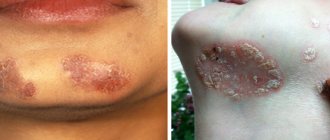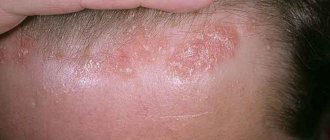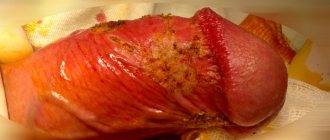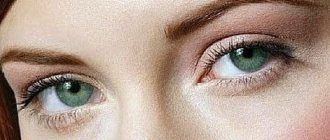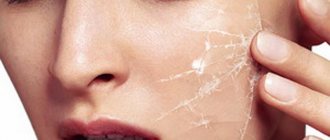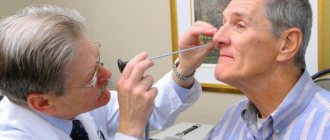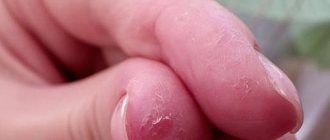The skin around the nose is peeling and red, what to do?
There is a whole list of reasons why the skin around the nose peels and becomes covered with red spots. Such symptoms are not always an aesthetic problem. In some cases, they indicate disturbances in the functioning of the body. Be sure to find out why the pathology occurred. This will help you choose the right treatment and restore your healthy appearance.
Why does the skin peel around the nose?
When old cells die and do not have time to exfoliate naturally, light scales appear on the skin, giving a person a sickly appearance. The main cause of dryness is considered to be a violation of the water-fat balance. The pathological process is facilitated by:
- chapping of the face;
- exposure to ultraviolet radiation;
- unsuitable cosmetic care products;
- avitaminosis;
- temperature difference;
- chronic fatigue and stress.
Around the nose there are large sebaceous glands that influence the formation of blackheads and pimples. The inflammatory process causes the skin to become red and flaky.
Respiratory diseases cause a negative reaction. Instillation of medicinal drops into the nose and discharge of mucus provoke redness and itching. The person constantly wipes his nose with a handkerchief, increasing irritation. As healing progresses, the affected areas become covered with scales, which gradually disappear.
If irritation and peeling on the nose continues for a long time, do not ignore the problem, but get examined to exclude the development of dangerous diseases. Symptoms may be heralds:
- allergic reaction. The disease manifests itself chronically with a runny nose and lacrimation. There are inflamed areas around the nose that are very itchy;
- seborrheic dermatitis. The pathology is provoked by a fungus that causes excessive oiliness, pimples and red flaky spots on the nose;
- demodicosis. A microscopic mite attacks the sebaceous glands. Swelling and inflamed purple areas form on the face;
- diabetes mellitus The disease disrupts the functioning of internal organs and systems. The imbalance is manifested by itchy skin and flaking on the nose, hands and other parts of the body;
- psoriasis. An autoimmune disease affects healthy epidermal cells. A scaly layer appears on the skin. Psoriatic plaques are located not only around the nose, but also in the scalp, behind the ears, and under the armpits.
Important! The primary task to guarantee successful treatment is to find out why the skin on your face is peeling. Having gotten ahead of the provoking factor, eliminate its harmful influence. If this is not done, you will not be able to completely get rid of the redness.
What to do to prevent skin from peeling
Peeling can be eliminated with comprehensive preventive measures. Be sure to review your diet and include dishes rich in B vitamins, tocopherol and retinol. Eat more:
- fresh carrots;
- green vegetables;
- sea fish;
- dairy products;
- nuts;
- whole grain porridge.
Advice. Avoid eating citrus fruits, chocolate, smoked meats and pickles. They are a common cause of allergic reactions that appear on the nose.
Drink at least 2 liters of clean water daily to prevent lack of moisture in your cells. During the off-season, take vitamin complexes to increase the body's defenses.
A red, scaly nose does not tolerate hot or ice water. To wash your face, use mineral water at room temperature. Avoid alkaline soap. Cleanse with cosmetic milk or oatmeal.
- Grind the flakes with a coffee grinder and place in a plastic container.
- Before washing, pour a little powder into your palm and dilute with warm water until it becomes sour cream. Apply to face, massage the sides of the nose and rinse.
- Do not rub your skin with a towel. Gently blot the moisture with a napkin, wipe the dermis with tonic and apply moisturizer.
Do not use alcohol-based products for daily care. They dry out and increase flaking. When going outside in the summer, protect your face from ultraviolet radiation with special means. In winter, use a thick foundation that protects from frost and wind.
If the area around your nose is covered with white scales, under which red spots have formed, do not rush to clean them with your fingers. First, soak the peeling with water and lubricate with Vaseline. Take a piece of gauze, folded several times, and rub the affected areas, removing the scales. After completing the manipulation, rinse the epidermis with chamomile infusion, dry and lubricate with cream.
Recommendations from cosmetologists
Experts advise getting tested and, if peeling is a consequence of pathological processes in the body, undergoing appropriate therapy. To exclude a fungal infection, a scraping is taken from the reddened area. The doctor examines the scales and determines the presence of pathogenic flora.
Cosmetologists recommend a combination treatment, including:
- proper nutrition;
- salon treatments;
- medicinal ointments and creams;
- traditional methods.
Flaky skin near the nose ceases to bother you after a course of moisturizing professional masks. The doctor selects ingredients that match the type of epidermis. Good results are provided by collagen, hyaluronic acid, emollient oils, herbs, and seaweed.
Mesotherapy eliminates red spots and peeling on the nose. The procedure involves the injection of various drugs under the skin. To treat acne and relieve inflammation, absorbent and antibacterial agents are used, and moisturizing components are used to soften.
! Biorevitalization helps against severe dehydration. During the session, hyaluronic acid is injected into the deep layers of the skin. The procedure triggers cell regeneration, restores metabolic processes, and eliminates dryness and sagging.
When the wings of the nose peel off, cosmetologists offer salon peeling, hardware massage, and paraffin therapy. One of these procedures is shown in the video:
The best remedies for flaking around the nose
It is easier to achieve the best results by combining the use of pharmaceutical drugs and traditional methods. If the skin on your nose is peeling, carry out the procedures regularly and coordinate the actions with a cosmetologist. This will help prevent adverse reactions and worsening of the condition.
Pharmacy drugs
Pharmacies sell ointments and creams that eliminate the inflammatory process and remove peeling.
- Bepanten provides quick results. The ointment contains dexpanthenol, which, penetrating deep into the skin, is converted into vitamin B5. The substance activates metabolic processes, heals damage and rashes. Bepanten is applied to the cleansed dermis 1-2 times a day and rubbed in thoroughly.
- Pantoderm ointment is useful, which forms a protective film that protects from the harmful influences of the environment and accelerates healing. The ointment quickly soothes itching and removes peeling of the skin.
- It is useful to lubricate rough areas around the nose with baby cream with the addition of vitamins A and E, cosmetic Vaseline, including mink oil, and warm sea buckthorn oil.
If the skin around your nose is peeling due to allergies or a fungal infection, powerful medications are needed. Hydrocortisone ointment is highly effective. The product is distributed in a thin layer onto the areas of redness 1-2 times a day. The course of therapy is no longer than 2 weeks. You can buy Griseofulvin ointment, Mycocid lotion, Dermazol.
For seborrheic dermatitis the following are in demand:
- Nystatin ointment;
- Ketoconazole;
- zinc paste;
- Sulfuric ointment.
Redness caused by a runny nose is eliminated with oxolinic ointment or Viferon.
A persistent infection that causes redness between the sinuses is treated with antibiotics. Effective ointments: Gentamicin, Tetracycline, Erythromycin.
Attention! Use hormonal external agents and antibiotics only as prescribed by a doctor. They are fast-acting, but have many contraindications, so self-medication is unacceptable.
Traditional methods
Using unconventional methods, you can solve the problem caused by excessive dryness, chapping, and inappropriate cosmetic care. In other cases, traditional medicine recipes are used as auxiliaries that complement the main treatment.
Masks
Mix a spoonful of natural honey with mineral water in equal proportions. Apply to inflamed areas with a cotton pad, massage with your fingers, leave for 5 minutes and wash.
- A simple mask quickly copes with flaky skin on the nose. Pour a spoonful of oatmeal with a small amount of boiling milk. After 10 minutes, strain off excess liquid. Add a teaspoon of olive oil and May honey to the warm porridge. Apply the mixture to your nose. After 20 minutes, wash off the composition.
- Mash a large spoonful of homemade cottage cheese with a fork, after adding a spoonful of olive oil. Wash the parsley sprigs and chop. Take a spoon and mix with cottage cheese. Distribute over problem areas and do not rinse for 20 minutes.
- Pour a tablespoon of linden blossom into a glass of boiling water. After half an hour, filter. Place a spoonful of oatmeal and olive oil in a ceramic bowl and pour in the linden infusion a little at a time, stirring constantly. The composition should acquire the consistency of liquid sour cream. Lubricate the epidermis around the nose and face along the massage lines. After 15 minutes, clean the skin with a cotton pad soaked in linden infusion.
And this simple and affordable remedy will allow you to get rid of peeling after 2-3 applications:
Apply anti-flaking masks daily for a week. If the problem does not disappear during this time, consult a cosmetologist.
Conclusion
When the skin around the nose peels and turns red, this is an alarming signal that indicates problems caused by external or internal influences. To get rid of this unpleasant phenomenon, use comprehensive methods of struggle, including gentle cosmetic care, external products and salon procedures.
Incredible! Find out who is the most beautiful woman on the planet in 2020!
Source: //faceandcare.ru/chto-delat-esli-kozha-vokrug-nosa-shelushitsya-i-poyavlyayutsya-pokrasneniya/
Conclusion
When the skin on the nose peels, it is important to determine the cause. If this may be a symptom of a serious disease that requires complex treatment. But most often the problem can be solved by changing the principles of skin care. Compliance with the principles of proper nutrition and drinking balance also have a beneficial effect on the condition of the epidermis.
Simple home recipes or pharmacy creams will help solve the problem. The main thing is not to delay treatment.
Incredible! Find out who is the most beautiful woman on the planet in 2020!
Why the skin on and around the nose peels, causes and treatment of nasal peeling
Why does my nose peel? This happens due to the death of cells in the upper epidermal layer. First, slight redness appears on the skin, which soon appears under a film of dead tissue.
It is dead skin that causes unpleasant sensations - peeling, burning, itching, etc. This fact is very unpleasant and looks extremely unaesthetic. As soon as the dead epidermis begins to crumble, small wounds form underneath.
Many diseases and problems can arise from them, since dangerous bacteria and germs penetrate through them.
What warns you about the onset of peeling?
You can tell that the skin on your nose is peeling by the following symptoms:
- the appearance of redness on and around the nose;
- burning and itching;
- feeling of tightness and dryness of the skin;
- the appearance of swelling and pain in the irritated area.
This problem can occur in women, men and even children. Thus, peeling on, under and around the nose affects many people.
The skin can peel off due to changes in season and weather, place of residence, cosmetics, and diet. However, it can also be due to a very serious illness. Therefore, it is very important to establish why the problem occurred. It is necessary to understand the main factors that affect peeling and redness of the skin.
So, why does your nose peel?
Dermatologists identify several reasons that cause such an unpleasant symptom: allergic reactions; avitaminosis; runny nose; failure to comply with hygiene standards; external factors; various kinds of pathologies.
Varieties
They can be divided according to the duration of manifestation:
- The redness is temporary. The reason for this fact is a rush of blood, the redness in such cases is localized on the cheeks. It is caused by the high activity of blood vessels located directly under the skin. When the capillaries expand, redness occurs, and when they narrow, the complexion normalizes. Such redness usually does not last long.
- Longer lasting redness. They appear from damage by aggressive external components (both seasonal and cosmetic) and persist for several days until skin regeneration begins.
- Persistent redness. Redness caused by diseases and inflammatory processes will appear until the disease is completely eliminated. Until the problem is stopped, skin problems will not only not disappear, but threaten to get worse - the appearance of peeling and various rashes.
Allergy
Often, redness of the skin is caused by an allergic reaction of the human body. Most often, this causes itching, the epidermis becomes covered with scales, and people begin to sneeze. Provoking factors are certain substances in cosmetics or food products.
To combat allergies, it is necessary to undergo a treatment course prescribed by an experienced allergist, who will determine the source of such a reaction and prescribe the correct treatment. The patient, in turn, needs to exclude smoked, highly fried, spicy and fatty foods, instant foods and semi-finished products from the diet.
You should try to eat only healthy foods and drink still, clean water.
Why else does your nose peel?
Natural and folk remedies
The use of essential oils and vitamins A, E and C can sometimes help relieve symptoms in some patients. Below are some natural remedies that can be a good alternative in treatment.
Useful remedy for people who have facial redness such as eczema. In addition to reducing redness, colloidal oatmeal mask has moisturizing and anti-inflammatory properties.
To make the mask, you will need a glass of pure colloidal oatmeal. Just mix a few teaspoons with a little water. Then apply and let dry. Repeat the procedure up to 4 times a week.
According to health research, the polyphenols in green tea have anti-aging properties for the skin. This is good news for green and peppermint tea drinkers.
However, this method is not suitable for people with allergies to the plant.
Green tea can improve the condition of patients, especially those suffering from rosacea.
Other common remedies that can be used include apple cider vinegar, grapefruit seed extract, and honey.
Avitaminosis
When the skin peels not only on the nose, but also on the whole body, we can talk about the presence of vitamin deficiency. It usually appears in the spring, since the body is weakened at this time and has a reduced level of resistance to negative environmental factors. At the same time, the body experiences a severe deficiency of essential minerals and vitamins.
This pathology can appear due to unfavorable environmental conditions, drinking alcoholic beverages, smoking, and leading a sedentary lifestyle. In this case, the body weakens and is more susceptible to various diseases.
A deficiency of vitamins C and A causes the skin to become fragile; a low intake of vitamin E causes a deterioration in water balance, causing the skin to become dry.
How is a weakened body treated? To improve this condition, you need to regularly take a complex of vitamins. In addition, experts advise increasing the following foods in the patient’s diet: fatty fish, liver, fresh vegetables and fruits, herbs, boiled meat, chicken egg yolks, butter.
To treat vitamin deficiency, you need to give up all bad habits, take walks every day, lead an active lifestyle, drink two liters of water every day. From late autumn until spring, you can take a rosehip decoction, thanks to which the body will be saturated with all useful components.
Why does your nose peel when you have a runny nose?
What not to do if the skin under your nose is peeling and red
We have figured out why the skin around the nose is peeling, and finally we will give some general tips to help alleviate the condition. Do not pick off flakes of dead skin with your fingernails. It’s better to moisten the area with water using a cotton pad and carefully remove the soaked scales, and then treat the skin with moisturizing cream.
Be sure to eliminate all allergens from your body, including honey, chocolate, salty foods and hot spices. Try to protect your face from direct sun, which increases skin dryness.
Runny nose
When the wings of the nose peel, we can talk about the presence of a lingering runny nose. Accumulating mucus causes skin irritation, and since a person constantly strives to remove it, micro-wounds and redness appear.
At home, you can get rid of a runny nose by rinsing your nose with sea water, inhalation, and instilling special solutions. If the case is advanced, then only complex treatment will help. After effective therapy, all irritations around the nose will be eliminated, and the skin will gradually return to its normal state.
What do seals on the wings of the nose mean?
Compaction is usually associated with the appearance of a disease such as rhinophyma. This is a disease of the skin of the nose. Sometimes it can be in the form of a benign tumor-like formation. Everything is characterized by hypertrophy of connective tissue, sebaceous glands and blood vessels.
The nose usually increases in size and loses its natural shape. A lump appears on its wings, similar to tubercles or bumps, which may be purple or dark red in color. When pressed, the nose hurts. Breathing problems may occur later. Rhinophyma can appear against the background of demodicosis or due to chronic inflammation of the skin.
Also common reasons for its appearance are:
- unfavorable environmental conditions;
- excessive alcohol consumption;
- problems with the gastrointestinal tract;
- endocrine diseases;
- chemotherapy;
- autoimmune diseases.
Failure to comply with hygiene rules
If the skin near the nose, forehead and cheeks, as well as around the mouth peels, we can say that the person is using the wrong cream, foam, gel or facial milk, or soap.
This may be due to his body’s reaction to the composition of cosmetic products, and as a result, instead of moisturizing the skin, on the contrary, they dry it out. That is why it is advisable to use cosmetics from time-tested companies.
It should contain the necessary vegetable oils and fats that moisturize the skin and nourish it with microelements and minerals. It is advisable to entrust the choice of cosmetics to a specialist - a cosmetologist or dermatologist.
Why does the tip of the nose peel?
Piercing
The fashion for piercing has given rise to a large number of new inflammatory processes. Non-healing wounds are a big problem, especially if the piercing is done in such a sensitive place as the nose.
Source: //osp-sakhalin.ru/lico/pochemu-shelushitsya-nos.html
Prevention of peeling
Properly selected cosmetic products are an excellent prevention of peeling. Creams and tonics that suit your skin type and mild cleansers allow you to not worry about the condition of the epidermis. It is better to wash your face with soft, purified water at room temperature.
In windy weather, apply protective creams to your skin. They will prevent chapping. In winter, avoiding water-based moisturizers will prevent dry skin. It is worth choosing products with a denser texture and a higher content of nutritional ingredients. In the summer heat, don't forget about UV protection.
To prevent otomycosis in summer, you can wipe your face with lemon water. Add a small amount of freshly squeezed lemon juice to the filtered water. This will prevent the development of fungal skin lesions.
It is important to avoid stress as much as possible and monitor your sleep and wakefulness patterns. Overwork weakens the immune system and provokes skin problems, including peeling.
Maintaining a drinking balance will prevent dehydration of the body and keep the skin smooth and elastic. A sufficient intake of vitamins and minerals from food will help prevent flaking on the nose. You need to eat more fresh vegetables, fruits, and fatty fish.
How to treat redness and peeling under the nose: causes, treatment
In this article you will learn why redness and flaking of the skin under the nose occurs, as well as the reasons for the appearance of an unpleasant defect. You will understand which medications are suitable for treating skin, when and how to use them. You will receive several effective folk recipes for moisturizing and healing damage and learn how to use them correctly.
Causes and treatment
Redness or peeling under the nose is often perceived as a cosmetic defect that has nothing to do with illness. However, medical practice shows that skin changes occur under the influence of two groups of factors:
- environmental exposure;
- pathological changes in the body.
The first group is associated with negative weather or temperature conditions that provoke peeling and redness (burns, frostbite, chapping, etc.), mechanical effects on the skin. Treatment consists of selecting medications to protect the skin from aggressive external factors and heal wounds and microcracks.
The second group is associated with painful changes in the body, and peeling of the skin under the nose is only one of the symptoms of pathology. Treatment consists not only of healing and softening the skin, but also of eliminating the internal disease.
Drugs for the treatment of redness under the nose are selected only by a doctor based on an external examination and laboratory tests.
Dermatovenerologist Irina Igorevna Lazuk will talk about the causes of peeling of the facial skin under the nose and in the mouth area. After watching the video, you will understand when you should see a doctor and when you can get by with moisturizers at home.
Environment
The easiest way to cure redness under the nose is if it was the result of a burn or frostbite. To heal the skin, dermatologists recommend ointments:
- "Panthenol" (analogue of "Pantestin"). This is an effective dexpanthenol-based product that quickly heals wounds and microcracks. Dexpanthenol penetrates cells and turns into pantothenic acid, which accelerates tissue regeneration. To get rid of flaking, lubricate the skin under your nose up to 3 times a day.
- "Aekol" . A medicine based on an oil solution of vitamins A, K, E. It stimulates skin regeneration, acts as an antioxidant, and relieves inflammation. To treat redness, apply the ointment to a piece of gauze and apply to the affected area. Repeat the procedure 2-3 times a day until the skin heals.
- "Algofin" . A medicine based on chlorophyll-carotene paste. It destroys pathogenic bacteria, relieves inflammation and promotes healing. To get rid of peeling, lubricate the skin 2-3 times a day for a week.
- "Wundehil" . An ointment with a natural composition, which includes propolis, sophora, yarrow and other ingredients. "Wundehil" heals wounds well and accelerates regeneration. To get rid of inflammation, lubricate the skin 2-3 times a day for a week.
- "Methyluracil" . A healing medicine with the same active ingredient. It enhances regeneration and relieves inflammation well. Continue treatment for 2-3 weeks, applying the ointment to the skin under the nose 1-2 times a day.
- Sudocrem and zinc-based preparations. Zinc ointment, Sudocrem and its direct analogues, which contain zinc (for example, Bübchen cream), can relieve inflammation and improve skin condition within 1-2 days. Zinc promotes healing and protects the skin from external negative influences. 1 week is enough for a course of therapy. During this period, apply the ointment 1-2 times a day to the affected area.
Before choosing an ointment, consult your doctor. Some components of the medication may cause an allergic reaction.
Mechanical effect on the skin
Redness and peeling of the skin under the nose also occur due to mechanical effects:
- squeezing out blackheads or pimples;
- piercing;
- frequent use of breathing masks at risk of developing apnea and asthma.
This skin irritation does not require special treatment. Wound healing creams (Pantestin, Sudocrem) and eliminating the main cause of skin damage are enough.
Rosacea
One of the causes of redness under the nose is rosacea. This is the name of a disease characterized by persistent redness of the facial skin with the formation of papules, swelling, and pustules.
In addition to redness near the nose, other symptoms indicate rosacea:
- oily skin on the forehead;
- formation of red acne on the face;
- itching, dry eyes;
- periodic feeling of a rush of blood to the skin of the face.
Treatment of rosacea is complex and includes a number of measures:
- giving up bad habits (smoking, alcohol);
- diet excluding salty and spicy foods;
- taking antibiotics to eliminate pathological microflora (Tetracycline, Doxycycline, Minocycline) and the antiparasitic drug Metronidazole;
- local treatment with Skinoren gel or Ovante cream with crystalline sulfur to eliminate inflammation and swelling;
- the use of ointments with metronidazole “Metrogil”, “Rozamet”;
- taking vitamin preparations to strengthen the walls of blood vessels (“Ascorutin”, “Antistax”);
- use of antihistamines (Cetrin, Suprastin);
- physical therapy to smooth out the skin (dry ice treatment, liquid nitrogen therapy).
Rosacea is not a dangerous disease, but it causes a lot of discomfort and requires long-term treatment.
Dermatitis
The cause of redness can be 2 types of dermatitis:
- perioral;
- seborrheic.
Perioral dermatitis occurs as a result of rosacea, infectious skin lesions, as well as the use of certain toothpastes, hormonal creams and cosmetics. The disease is characterized by redness of the skin, itching and peeling.
Seborrheic dermatitis most often occurs on the scalp, but can also affect areas of the skin on the face. The disease is characterized by peeling of the skin, while the feeling of excessive sebum secretion persists.
Treatment for dermatitis depends on its type. For oral disease, it is sufficient to use healing preparations based on zinc (Sudocrem, zinc ointment). If a bacterial infection occurs, antibiotics are prescribed, for example, Tetracycline. You should also stop using nasal sprays and hormonal ointments.
Seborrheic dermatitis is fungal in nature, therefore it is treated with antimycotic tablets “Orungal”, “Nizoral” and others. They effectively destroy mold and yeast. For external use, antifungal ointments “Keto Plus”, “Zalain” and others are recommended.
ARVI and acute respiratory infections
Respiratory viral diseases most often cause a runny nose, which results in irritation of the skin under the nose. To treat skin lesions, only wound-healing creams and ointments are not enough: the cause must be eliminated.
For the treatment of ARVI, antiviral drugs “Cycloferon”, “Anaferon”, “Kagocel” and others are prescribed. To rinse your nose, use nasal sprays “Aqualor”, “Dolphin”, “Aquamaris”.
To remove nasal discharge, do not use wet alcohol wipes or rough cloths. They quickly irritate the skin when rubbed and dry it out, causing redness and flaking. It is best to blow your nose under running tap water: the impact on the skin under the nose will be minimal.
Demodicosis
This is what is called skin damage by subcutaneous mites. The main symptoms of the disease are itching, peeling, and redness of the skin due to the movement of microorganisms under the skin.
To diagnose the disease, laboratory testing of skin scrapings and samples is used. If the diagnosis is confirmed, the doctor prescribes drugs based on tinidazole and metronidazole (Permethrin, Metronidazole, Metrogyl). They destroy mites, create a cooling effect and restore the skin.
Folk remedies
The use of folk remedies for peeling skin under the nose is effective at the initial stage of development of the defect, if the cause of its appearance was environmental or mechanical influence.
If we are talking about a disease, folk recipes are used only for healing. The main treatment is to eliminate the cause, namely internal pathology.
Oatmeal mask
Ingredients:
- A glass of colloidal oatmeal.
- Water.
How to prepare: Take 3-4 tsp. oatmeal and mix with the same amount of clean water. Mix until moist and homogeneous.
How to use: Apply the mixture to reddened facial skin and leave for 15-20 minutes. Then rinse with warm water. Repeat treatment 4 times a week.
Result: Oatmeal relieves inflammation and moisturizes the skin. The redness gradually subsides, the peeling disappears.
Flax seed decoction
Ingredients:
- Flax seeds – 2 tbsp. L.
- Water – 2 tbsp.
How to cook: Pour water over the seeds and put on fire. Boil and cook the mixture until it becomes like a paste. Cool and strain.
How to use: Apply the pulp of brewed seeds to the affected area of the skin for 20 minutes, then remove it and wash with warm water. Repeat the mask 4-5 times a week.
Result: Flax seeds act as a scrub on the skin. Peeling and redness go away. The skin area becomes smoother.
Mustard mask
Ingredients:
- Dry mustard – 1 tsp.
- Vegetable oil – 1 tbsp. l.
How to prepare: Mix oil with mustard and add a little boiled water to form a thick, homogeneous mass.
How to use: Apply the mask to the skin for 5 minutes, then wash well. Make a mask 4-5 times a week. Do not keep the mask on your face for longer than the specified time to avoid getting burned.
Result: The product is suitable for dry, very flaky skin. The skin is moisturized, dead epithelium is exfoliated, healing occurs faster.
General recommendations and prevention
To avoid the formation of redness and peeling under the nose and speed up skin healing, doctors recommend the following measures:
- Avoid using low-quality cosmetics that can cause allergies and irritating products (alcohol tinctures, methanol, facial scrubs). If you have skin problems, do not use hormonal ointments and creams without your doctor's knowledge. Progesterone pills for women can worsen the condition of the skin.
- Do not rub the affected area of the skin, do not squeeze out pimples and pustules. Do not pick off flaking skin: to remove dead epithelium, first moisten the affected area with water.
- In cold weather, apply a rich cream or natural fat, such as goose fat, to the skin around the nose. Do not use vegetable oils for these purposes: they greatly dry out the skin and worsen their condition.
- Avoid bad habits such as drinking alcohol or smoking.
- Eat healthy foods, avoiding overly salty and bitter foods.
- In the autumn-spring period, take vitamin complexes (Vitrum, Aevit) to strengthen the immune system and improve skin condition.
- In severe cases, in the absence of contraindications, resort to cosmetic procedures, such as chemical peeling.
Answers on questions
Can oil-based vitamins be used to treat flaking?
Oil-based vitamins A and E have a good effect on the skin. However, you cannot apply them yourself to the affected area. Add vitamins to masks or peeling products.
Can autoimmune diseases cause redness?
Autoimmune diseases can cause redness of the skin under the nose, as well as on the cheeks. One of these pathologies is lupus. Another common autoimmune disease is psoriasis. To treat these diseases, immunostimulants are used, which can only be prescribed by a doctor after diagnosis and laboratory tests.
Can diabetes cause peeling?
Peeling skin is often present in diabetes, but is not a mandatory symptom. To confirm the diagnosis, you need to donate blood for sugar. However, along with elevated sugar levels, there may be other causes of peeling, so do not rush to conclusions. Only a doctor can prescribe the final diagnosis and treatment.
What to remember
- If there is peeling under the nose, avoid using any cosmetics or medications that irritate the skin.
- Eliminate contact with potential allergens.
- If you suspect a disease of the internal organs, go to see a doctor and do not take any measures until laboratory tests are performed and a diagnosis is made.
- In cold and dry weather, use rich creams to protect your skin.
- Use folk remedies to moisturize and relieve inflammation.
Source: //nashdermatolog.ru/simptomy/kak-lechit-krasnotu-i-shelushenie-pod-nosom.html
